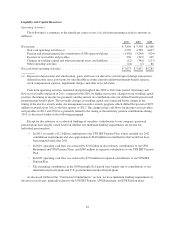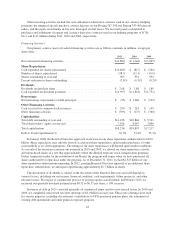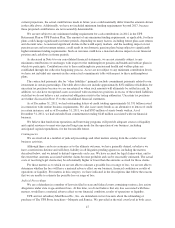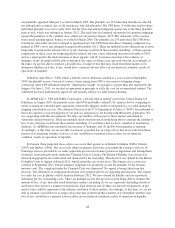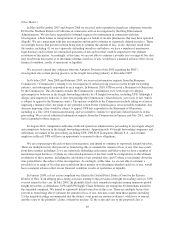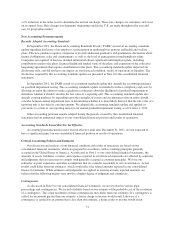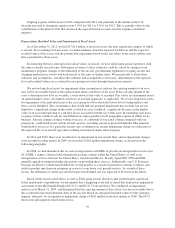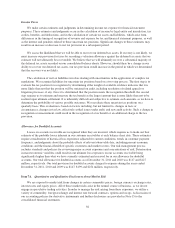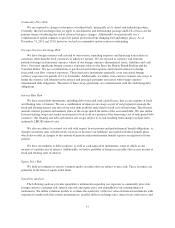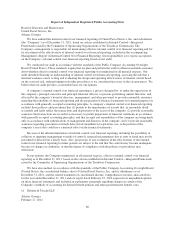UPS 2011 Annual Report Download - page 64
Download and view the complete annual report
Please find page 64 of the 2011 UPS annual report below. You can navigate through the pages in the report by either clicking on the pages listed below, or by using the keyword search tool below to find specific information within the annual report.The events that may impact our contingent liabilities are often unique and generally are not predictable. At
the time a contingency is identified, we consider all relevant facts as part of our evaluation. We record a liability
for a loss when the loss is probable of occurring and reasonably estimable. Events may arise that were not
anticipated and the outcome of a contingency may result in a loss to us that differs from our previously estimated
liability. These factors could result in a material difference between estimated and actual operating results.
Contingent losses that are probable and estimable, excluding those related to income taxes and self-insurance
which are discussed further below, were not material to our financial position as of December 31, 2011. In
addition, we have certain contingent liabilities that have not been recognized as of December 31, 2011, because a
loss is not reasonably estimable.
Goodwill and Intangible Impairment
We perform impairment testing of goodwill for each of our reporting units on an annual basis. Our reporting
units are comprised of the Europe, Asia, and Americas reporting units in the International Package reporting
segment, and the Forwarding, Logistics, UPS Freight, MBE / The UPS Store and UPS Capital reporting units in
the Supply Chain & Freight reporting segment. Our annual goodwill impairment testing date is October 1st for
each reporting unit. In assessing goodwill for impairment, we initially evaluate qualitative factors to determine if
it is more likely than not that the fair value of a reporting unit is less than its carrying amount. If the qualitative
assessment is not conclusive and it is necessary to calculate the fair value of a reporting unit, then we utilize a
two-step process to test goodwill for impairment. First, a comparison of the fair value of the applicable reporting
unit with the aggregate carrying value, including goodwill, is performed. If the carrying amount of a reporting
unit exceeds the reporting unit’s fair value, we perform the second step of the goodwill impairment test to
determine the amount of impairment loss. The second step includes comparing the implied fair value of the
affected reporting unit’s goodwill with the carrying value of that goodwill.
We primarily determine the fair value of our reporting units using a discounted cash flow model (“DCF
model”), and supplement this with observable valuation multiples for comparable companies, as applicable. The
completion of the DCF model requires that we make a number of significant assumptions to produce an estimate
of future cash flows. These assumptions include projections of future revenue, costs and working capital changes.
In addition, we make assumptions about the estimated cost of capital and other relevant variables, as required, in
estimating the fair value of our reporting units. The projections that we use in our DCF model are updated
annually and will change over time based on the historical performance and changing business conditions for
each of our reporting units. The determination of whether goodwill is impaired involves a significant level of
judgment in these assumptions, and changes in our business strategy, government regulations or economic or
market conditions could significantly impact these judgments. We will continue to monitor market conditions
and other factors to determine if interim impairment tests are necessary in future periods. If impairment
indicators are present in future periods, the resulting impairment charges could have a material impact on our
results of operations.
None of the reporting units incurred any goodwill impairment charges in 2011, 2010 or 2009. Changes in
our forecasts could cause carrying values of our reporting units to exceed their fair values in future periods,
potentially resulting in a goodwill impairment charge. As of our October 1, 2011 goodwill impairment testing
date, our UPS Freight reporting unit’s fair value exceeded its carrying value by approximately 10%. The fair
value of this reporting unit was negatively impacted in 2011 by the difficult market environment for the LTL
industry, resulting in reduced equity valuations for market comparable companies. Several factors, including
lower than expected revenues and/or operating margins, an increased cost of capital and higher than anticipated
capital expenditure requirements, could result in the reporting unit’s fair value declining below its carrying value
in a future period. Additionally, a sustained decline in the valuations of publicly-traded comparable companies in
the LTL industry would also reduce the calculated fair value of this reporting unit. Our UPS Freight reporting
unit has a total goodwill balance of $441 million as of December 31, 2011. A 10% decrease in the estimated fair
value of our other reporting units as of our most recent goodwill testing date (October 1, 2011) would not result
in a goodwill impairment charge.
52


